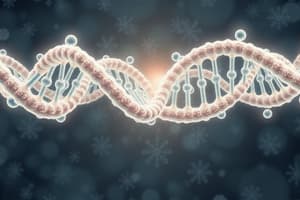Podcast
Questions and Answers
Which region of the chromosome is designated as 'p'?
Which region of the chromosome is designated as 'p'?
- The centromere
- The long chromosome arm
- The short chromosome arm (correct)
- The telomere
Which phase of the cell cycle does DNA replication occur?
Which phase of the cell cycle does DNA replication occur?
- G1
- G0
- S (correct)
- G2
What is the function of the G1 checkpoint control mechanism?
What is the function of the G1 checkpoint control mechanism?
- To ensure that everything is ready for DNA synthesis (correct)
- To check if the cell is ready to complete cell division
- To stop cell growth and focus on cell division
- To ensure that everything is ready to enter the M phase
Which proteins control the cell cycle?
Which proteins control the cell cycle?
Which chromosome type has a centromere that is more central?
Which chromosome type has a centromere that is more central?
What is the abbreviation for the resting phase where the cell has left the cycle and stopped dividing?
What is the abbreviation for the resting phase where the cell has left the cycle and stopped dividing?
Which checkpoint control mechanism ensures that everything is ready to enter the M (mitosis) phase and divide?
Which checkpoint control mechanism ensures that everything is ready to enter the M (mitosis) phase and divide?
What is the abbreviation for the phase of the cell cycle where cell growth stops and cellular energy is focused on the orderly division into two daughter cells?
What is the abbreviation for the phase of the cell cycle where cell growth stops and cellular energy is focused on the orderly division into two daughter cells?
Which chromosome type has a centromere that is less central?
Which chromosome type has a centromere that is less central?
Which region of the chromosome is designated as 'q'?
Which region of the chromosome is designated as 'q'?
Which molecule carries the genetic information needed to specify all aspects of what makes a human being a functional organism?
Which molecule carries the genetic information needed to specify all aspects of what makes a human being a functional organism?
Where is the human genome found in the body?
Where is the human genome found in the body?
What is the approximate number of genes in the human genome?
What is the approximate number of genes in the human genome?
What are the components of nucleic acids?
What are the components of nucleic acids?
How are the nucleic components of DNA held together?
How are the nucleic components of DNA held together?
Which nitrogenous base is found in both DNA and RNA?
Which nitrogenous base is found in both DNA and RNA?
Which molecule is composed of a nucleoside and one or more phosphate groups?
Which molecule is composed of a nucleoside and one or more phosphate groups?
NTP is found in?
NTP is found in?
An example of a di-nucleotide is
An example of a di-nucleotide is
Which one of the following is NOT a function of nucleotides?
Which one of the following is NOT a function of nucleotides?
Which enzyme deficiency is associated with Hypouricemia?
Which enzyme deficiency is associated with Hypouricemia?
Which enzyme deficiency is associated with Hyperuricemia in Lesch-Nyhan Syndrome/Juvenile Gout?
Which enzyme deficiency is associated with Hyperuricemia in Lesch-Nyhan Syndrome/Juvenile Gout?
Which enzyme deficiency is associated with Severe Combined Immunodeficiency Diseases (SCID)?
Which enzyme deficiency is associated with Severe Combined Immunodeficiency Diseases (SCID)?
What is the result of an immune system highly compromised in SCID?
What is the result of an immune system highly compromised in SCID?
match the sources of each required component of purine synthesis.
match the sources of each required component of purine synthesis.
HGPRT is an enzyme used to change hypoxanthine into _____ and Xanthine into _____.
HGPRT is an enzyme used to change hypoxanthine into _____ and Xanthine into _____.
In the purine degradation process, Inosine is catalyzed to hypoxanthine by?
In the purine degradation process, Inosine is catalyzed to hypoxanthine by?
The over expression of deaminase can cause?
The over expression of deaminase can cause?
Sources of carbon and nitrogen for pyrimidine synthesis.
Sources of carbon and nitrogen for pyrimidine synthesis.
Uracil is degraded to what during the degradation process of pyrimidines?
Uracil is degraded to what during the degradation process of pyrimidines?
Thymidine is degraded to what during the degradation process of pyrimidines?
Thymidine is degraded to what during the degradation process of pyrimidines?
What enzyme is used to synthesize deoxyribose from ribose
What enzyme is used to synthesize deoxyribose from ribose
Thymidylate (dTMP) requires?
Thymidylate (dTMP) requires?
Inhibitors of thymidylate synthesis that directly inhibit the dihydrofolate reductase (DHFR).
Inhibitors of thymidylate synthesis that directly inhibit the dihydrofolate reductase (DHFR).
Everything is true about pyrimidine synthesis except?
Everything is true about pyrimidine synthesis except?
Inhibitor of thymidylate synthase.
Inhibitor of thymidylate synthase.
chain growth is always ____ to ____.
chain growth is always ____ to ____.
A process to put nucleotide together is called?
A process to put nucleotide together is called?
What provides the monomers and energy needed for polymerization?
What provides the monomers and energy needed for polymerization?
Define Bidirectional:
Define Bidirectional:
Prokaryotic polymerase that is considered the main processive replicative enzyme.
Prokaryotic polymerase that is considered the main processive replicative enzyme.
Replication enzyme functions
Replication enzyme functions
DNA polymerase roles in eukaryotic DNA synthesis.
DNA polymerase roles in eukaryotic DNA synthesis.
Exonucleases are defined as?
Exonucleases are defined as?
All of these DNA synthesis inhibitors are considered chemotherapeutic agents except?
All of these DNA synthesis inhibitors are considered chemotherapeutic agents except?
Karyotyping is usually done using chromosomes in what phase?
Karyotyping is usually done using chromosomes in what phase?
Euchromatin is the ___ type of chromatin and predominantly found in cells during ___.
Euchromatin is the ___ type of chromatin and predominantly found in cells during ___.
What reactions is considered the foundation of protein activation?
What reactions is considered the foundation of protein activation?
Telomeres serves as a termination zone.
Telomeres serves as a termination zone.
In humans, the sequence used as the "cap" is?
In humans, the sequence used as the "cap" is?
The erosion of the telomeres will affect the cell function
The erosion of the telomeres will affect the cell function
Flashcards
Short arm of a chromosome
Short arm of a chromosome
Designated as 'p', representing the shorter part of a chromosome.
S phase
S phase
The phase of the cell cycle where DNA replication occurs.
G1 checkpoint
G1 checkpoint
Checks cell size and integrity before DNA synthesis in the cell cycle.
Cyclins and CDKs
Cyclins and CDKs
Signup and view all the flashcards
Metacentric chromosomes
Metacentric chromosomes
Signup and view all the flashcards
Acrocentric chromosomes
Acrocentric chromosomes
Signup and view all the flashcards
G0 phase
G0 phase
Signup and view all the flashcards
G2/M checkpoint
G2/M checkpoint
Signup and view all the flashcards
M phase
M phase
Signup and view all the flashcards
Long arm of a chromosome
Long arm of a chromosome
Signup and view all the flashcards
Human genome
Human genome
Signup and view all the flashcards
Components of nucleic acids
Components of nucleic acids
Signup and view all the flashcards
Phosphodiester bonds
Phosphodiester bonds
Signup and view all the flashcards
Nitrogenous base in DNA/RNA
Nitrogenous base in DNA/RNA
Signup and view all the flashcards
NTPs
NTPs
Signup and view all the flashcards
Dipeptide nucleotides
Dipeptide nucleotides
Signup and view all the flashcards
Hypouricemia
Hypouricemia
Signup and view all the flashcards
Hyperuricemia
Hyperuricemia
Signup and view all the flashcards
Severe Combined Immunodeficiency
Severe Combined Immunodeficiency
Signup and view all the flashcards
HGPRT function
HGPRT function
Signup and view all the flashcards
Inosine and hypoxanthine
Inosine and hypoxanthine
Signup and view all the flashcards
Pyrimidine synthesis substrates
Pyrimidine synthesis substrates
Signup and view all the flashcards
Uracil and thymidine degradation
Uracil and thymidine degradation
Signup and view all the flashcards
Thymidylate synthase
Thymidylate synthase
Signup and view all the flashcards
DHFR inhibitors
DHFR inhibitors
Signup and view all the flashcards
DNA replication direction
DNA replication direction
Signup and view all the flashcards
Exonucleases
Exonucleases
Signup and view all the flashcards
Karyotyping
Karyotyping
Signup and view all the flashcards
Euchromatin
Euchromatin
Signup and view all the flashcards
Telomere structure
Telomere structure
Signup and view all the flashcards
Impact of telomere erosion
Impact of telomere erosion
Signup and view all the flashcards
Study Notes
Chromosome and Cell Cycle Basics
- 'p' designates the short arm of a chromosome.
- DNA replication occurs in the S phase of the cell cycle.
- The G1 checkpoint controls whether the cell is ready to proceed to DNA synthesis, assessing cell size and integrity.
- Cyclins and cyclin-dependent kinases (CDKs) are pivotal proteins controlling the cell cycle.
- Metacentric chromosomes have a centromere that is centrally located, while acrocentric chromosomes have a centromere that is near one end.
Cell Cycle Phases and Checkpoints
- The resting phase where the cell has exited the cycle is abbreviated as G0.
- The G2/M checkpoint ensures all is ready for the M phase and division.
- The M phase focuses cellular energy on the orderly division into two daughter cells.
Genetic Information and Human Genome
- 'q' designates the long arm of a chromosome.
- DNA carries genetic information essential for human function.
- The human genome resides in the nuclei of cells.
- The approximate number of genes in the human genome is around 20,000 to 25,000.
Nucleic Acids and Their Components
- Nucleic acids consist of nucleotides, which include a sugar, a phosphate group, and a nitrogenous base.
- The nucleotides in DNA are held together by phosphodiester bonds.
- Adenine is a nitrogenous base found in both DNA and RNA.
- Nucleotides, which are composed of a nucleoside and one or more phosphate groups, include NTPs.
Enzymes and Disorders Related to Nucleotides
- Dipeptide nucleotides serve as an example of di-nucleotides.
- The function that is NOT associated with nucleotides is their role as genetic information carriers.
- Hypouricemia is linked to the deficiency of the enzyme xanthine oxidase.
- Hyperuricemia in Lesch-Nyhan Syndrome and juvenile gout is due to a deficiency in hypo-xanthine guanine phosphoribosyltransferase (HGPRT).
- Severe Combined Immunodeficiency Diseases (SCID) are associated with an adenosine deaminase deficiency, leading to a severely compromised immune system.
Purine and Pyrimidine Synthesis
- HGPRT converts hypoxanthine to inosine monophosphate (IMP) and xanthine to uric acid.
- In purine degradation, inosine is catalyzed to hypoxanthine by purine nucleoside phosphorylase.
- Overexpression of deaminase can lead to toxic effects on cells.
- Pyrimidine synthesis requires sources of carbon and nitrogen derived from aspartate and glutamine, respectively.
- Uracil degrades to beta-alanine, while thymidine degrades to beta-aminoisobutyric acid (BAIB).
Enzyme Functions and Inhibitors
- Thymidylate synthase enzymatically synthesizes deoxyribonucleotides.
- Dihydrofolate reductase (DHFR) inhibitors block thymidylate synthesis.
- Chain growth in nucleic acid synthesis follows the template direction.
- The process of assembling nucleotides is termed DNA replication.
- Monomers and energy for polymerization are provided by nucleotides and ATP.
DNA Synthesis and Chromatin Structure
- Bidirectional replication refers to simultaneous synthesis of DNA in both directions from a replication origin.
- DNA polymerase III is the primary prokaryotic enzyme for replicative processes.
- Eukaryotic DNA polymerases also play key roles during DNA synthesis.
- Exonucleases remove nucleotide residues from DNA, ensuring fidelity and correcting errors.
- Karyotyping is typically performed on chromosomes in the metaphase stage.
- Euchromatin is loosely packed chromatin, predominantly found in active cells.
Telomeres and Cellular Function
- The "cap" sequence in humans used for telomere protection consists of repeated TTAGGG sequences.
- Erosion of telomeres impacts cell longevity and function, leading to cellular aging and dysfunction.
Studying That Suits You
Use AI to generate personalized quizzes and flashcards to suit your learning preferences.





